
The Big South Fork of the Cumberland River is a 76-mile-long (122 km) river in the U.S. states of Tennessee and Kentucky. It is a major drainage feature of the Cumberland Plateau, a major tributary of the Cumberland River system, and the major feature of the Big South Fork National River and Recreation Area.

The dwarf wedgemussel is an endangered species of freshwater mussel, an aquatic bivalve mollusk in the family Unionidae, the river mussels.

The Unionidae are a family of freshwater mussels, the largest in the order Unionida, the bivalve molluscs sometimes known as river mussels, or simply as unionids.

Unionida is a monophyletic order of freshwater mussels, aquatic bivalve molluscs. The order includes most of the larger freshwater mussels, including the freshwater pearl mussels. The most common families are the Unionidae and the Margaritiferidae. All have in common a larval stage that is temporarily parasitic on fish, nacreous shells, high in organic matter, that may crack upon drying out, and siphons too short to permit the animal to live deeply buried in sediment.
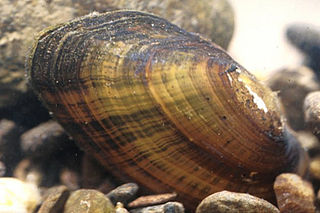
Alasmidonta is a genus of freshwater mussels, aquatic bivalve mollusks in the family Unionidae, the river mussels.

The Appalachian elktoe is a species of freshwater mussel in the family Unionidae, the river mussels. It is native to the United States, where it is known only from North Carolina and Tennessee.

Cyprogenia is a genus of freshwater mussels, aquatic bivalve mollusks in the family Unionidae.

The fanshell is a species of aquatic bivalve mollusk in the family Unionidae. This clam is native to the United States, where breeding populations remain in only three rivers. It is a federally listed endangered species of the United States.
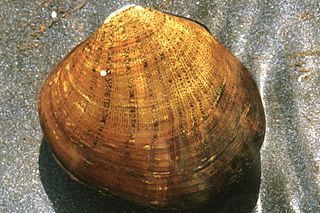
Dromus dromas, the dromedary pearlymussel or dromedary naiad, is a rare species of freshwater mussel in the family Unionidae. This aquatic bivalve mollusk is native to the Cumberland and Tennessee River systems in the United States, where it has experienced a large population decline. It is a federally listed endangered species of the United States.

Epioblasma is a genus of freshwater mussels, aquatic bivalve mollusks in the family Unionidae, the river mussels. Most of the species in this genus have been lost in modern times, and the entire genus is threatened with the possibility of extinction.

The oyster mussel is a rare species of freshwater mussel in the family Unionidae. This aquatic bivalve mollusk is native to the Cumberland and Tennessee River systems of Kentucky, Tennessee, Alabama, and Virginia in the United States. It has been extirpated from the states of Georgia and North Carolina. It is a federally listed endangered species of the United States.
Lampsilis rafinesqueana, the Neosho mucket or Neosho pearly mussel, is a species of North American freshwater mussel endemic to Arkansas, Oklahoma, Illinois, Missouri and Kansas.
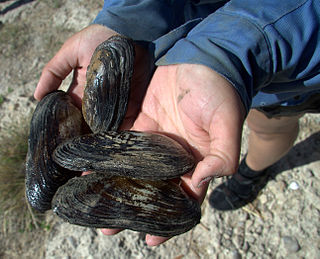
Popenaias popeii, common name the Texas hornshell, is a species of freshwater mussel, an aquatic bivalve mollusk in the family Unionidae, the river mussels.
The triangular kidneyshell is a species of freshwater mussel, in the family Unionidae, the river mussels. It is endemic to Alabama in the United States, where it is known from several rivers and streams in the Mobile River Basin. It is a federally listed endangered species of the United States.

Theliderma intermedia, the Cumberland monkeyface pearly mussel or Cumberland monkeyface, is a species of freshwater mussel in the family Unionidae, the river mussels. This aquatic bivalve mollusk is native to Tennessee and Virginia in the United States. Historically widespread in the upper Tennessee River system, it populations have been reduced by habitat destruction and pollution. It now only occurs in two tributaries: the Duck and Powell Rivers. It is a federally listed endangered species.

The glochidium is a microscopic larval stage of some freshwater mussels, aquatic bivalve mollusks in the families Unionidae and Margaritiferidae, the river mussels and European freshwater pearl mussels.
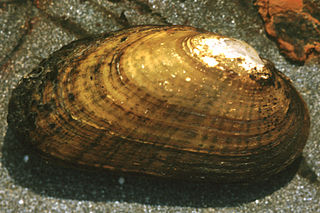
Villosa iris, the rainbow mussel or rainbow-shell, is a species of freshwater mussel, an aquatic bivalve mollusk in the family Unionidae, the river mussels.

The South Toe River is a river in Yancey County in Western North Carolina. The name Toe is taken from its original name Estatoe, pronounced 'S - ta - toe', a native American name associated with the Estatoe trade route leading down from the NC mountains through Brevard where there is a historical plaque with information that affirms the route, on into South Carolina where a village of the same name was located.
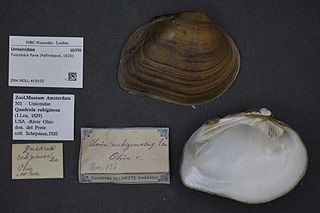
Fusconaia flava, the Wabash pigtoe, is a freshwater mussel in the family Unionidae.

Megalonaias nervosa is a freshwater mussel species in the family Unionidae. Washboard is the common name used for Megalonaias nervosa.
















